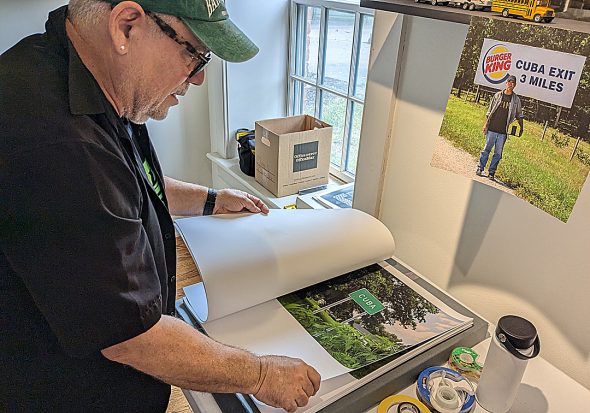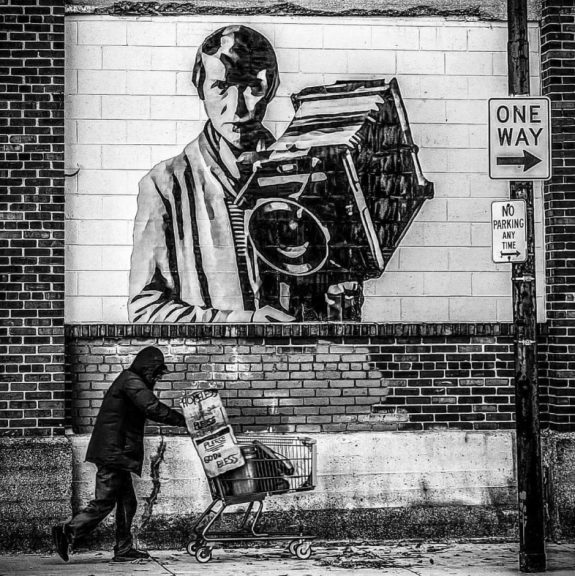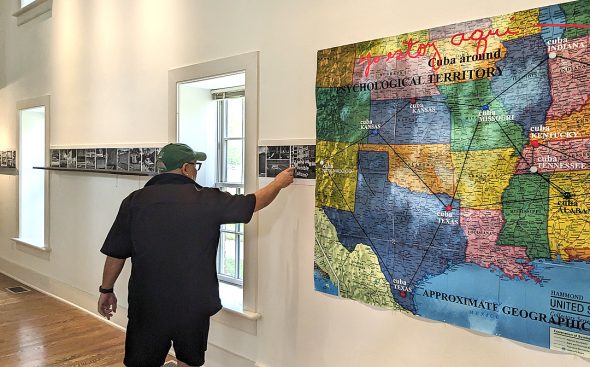
Multimedia artist Juan-Sí González riffles through color images he captured in some of America’s 16 towns and cities named after his home country, Cuba. The photos form the nucleus of his FotoFocus exhibition, “Looking for Cuba Inside,” at the Herndon Gallery. (Photo by Lauren "Chuck" Shows)
Yellow Springs to host two FotoFocus shows
- Published: October 5, 2024
The biennial FotoFocus program — which highlights the work of photographic artists across dozens of venues in and around Dayton, Cincinnati, Columbus and Northern Kentucky, all united by a common theme — returns this year.
The Herndon Gallery at Antioch College has played host to an exhibition during each iteration of FotoFocus since its inception in 2012. This year, however, the Herndon is joined by Crome YS, which will also host a show, doubling the local access to FotoFocus for area art-lovers.
Yellow Springs’ two venues join 84 others as part of this year’s program.
The theme for this year’s FotoFocus event is “backstories”; according to a press release, the theme “considers the full context of a photograph, exploring broader histories, and acknowledging that vital information which often does not make it into the frame.”
The News spoke recently with artists Shem Schutte, whose FotoFocus exhibition will be displayed at Crome YS; and Juan-Sí González, whose exhibition will open at Herndon Gallery, about their individual artistic approaches and how each exhibition interacts with both this year’s theme and the unique spaces that will host their shows.

The black and white photography of artist Shem Schutte, which often centers on locations around his hometown of Springfield, is featured in “Thinking Positive, Capturing Negatives” at Crome YS. (Submitted photo)
‘Thinking Positive, Capturing Negatives’
Shem Schutte, born and raised in nearby Springfield, can’t remember a time when he wasn’t fascinated with photography.
“I’m a fifth-generation photographer,” he said. “I’ve been seeing photographs, taking them and talking about them and in love with the whole process forever — I was lucky enough to be born into it.”
Schutte said his contribution to this year’s FotoFocus exhibition, titled “Thinking Positive, Capturing Negatives,” is meant to communicate a kind of glass-half-full approach to life and art; though many of the pieces Schutte has included in the exhibition linger in shadow, the artist aims to bring a sense of wonder to each image he captures.
And Schutte isn’t afraid of the dark — it’s where he prefers to work.
“Nighttime has always been my favorite time to shoot — it seems to be more free-range,” he said. “It’s a little easier at night; you have a little more control over what gets in the photo and what doesn’t.”
Schutte — whose work is often shot outside — said he prefers to keep his images “timeless,” often without text or the inclusion of people or vehicles that might anchor the image in a specific time period. Night shoots keep cars and people out of frame for the most part, and the long exposure times required for shooting with limited light — anywhere from 30 seconds to 10 minutes — allow Schutte’s images a kind of hyper-real sharpness and clarity.
“I try to stop down [increase the camera’s depth of field and focus] as much as I can so I can capture every detail,” Schutte said.
Schutte said the FotoFocus theme of “backstories” wasn’t a difficult one to find among his body of work — he considers each image he captures as a story of its own, left for the viewer to puzzle out on their own.

“Thinking Positive, Capturing Negatives” opens Friday, Oct. 11, with an artist reception beginning at 6 p.m. The exhibition will also be open Saturday, Oct. 12, 11 a.m.–3 p.m., featuring a midafternoon artist talk. Following these events, the exhibition will be open Fridays–Sundays, 11 a.m.–3 p.m., through Oct. 27, with an “Architect’s PechaKucha” Oct. 19 and a closing reception Oct. 27 with guest speaker Vicki Ruilli, of Itinerant Studio in Springfield. Admission is free. (Submitted photo)
“Any good, beautiful piece of art tells a story,” he said. “That’s always been part of my photography; you’ve got to have the composition, but you also have to have that little bit of mystery as well.”
A longtime lover of his hometown’s historic buildings, Schutte added that his lens is often directed toward the stories inherent in Springfield’s architecture.
“I’ve been shooting some of the same buildings for years, in a whole bunch of different ways and from different angles,” he said. “It’s been neat to see the evolution of where the shots come from — especially because some of those buildings are gone now.”
The artist’s interest in architecture made the exhibition a good fit for the interior of Crome YS, itself the headquarters of an architectural firm. The building — previously the historic local Baptist Church — was renovated and reopened in 2022, and since then has hosted a number of artists-in-residence and their accompanying exhibitions.
Schutte said he had originally intended to include a few dozen small photographs in his FotoFocus exhibition, but after touring Crome YS and noting its large, airy, light-filled open space, he took a different course.
“We all agreed that we had to go bigger, just so it didn’t all get lost in the space,” he said.
Ena Nearon, who curated Schutte’s exhibition and who has curated past FotoFocus exhibitions in and around Cincinnati, said finding harmony between the work and the exhibition space is one of the things she loves about her own work.
“Curators typically have a feel for the artists and working knowledge of available venues, so the whole process is a creative process,” she said. “People walk in and they see all of that collaboration.”
Though he described himself as “not religious,” Schutte said that, as a lover of buildings in general, he’s always had a soft spot for churches. In that way, Crome YS felt like a god-send as an exhibition space, he said.
“I love that feeling of walking into a kind of sacred space, and [Crome YS] has that feeling,” he said. “I wanted to keep that feeling, that integrity, with the show.”
Nearon added that, with its addition to the FotoFocus lineup this year, Crome YS acts as a “distinct, but complementary” space to the Herndon. And she added that, with the traffic FotoFocus often brings to host galleries, she hopes that a second location in Yellow Springs will help extend the village’s art-centric reputation.
“The difference, but uniqueness, of the two galleries positions Yellow Springs as a multivenue destination,” she said. “I hope that we can continue to have the two venues functioning for the rest of the biennials that come along.”
“Thinking Positive, Capturing Negatives” opens Friday, Oct. 11, with an artist reception beginning at 6 p.m. The exhibition will also be open Saturday, Oct. 12, 11 a.m.–3 p.m., featuring a midafternoon artist talk. Following these events, the exhibition will be open Fridays–Sundays, 11 a.m.–3 p.m., through Oct. 27, with an “Architect’s PechaKucha” Oct. 19 and a closing reception Oct. 27 with guest speaker Vicki Ruilli, of Itinerant Studio in Springfield. Admission is free.

“Looking for Cuba Inside” opens Saturday, Oct. 5, with a reception and artist talk, 4–6 p.m. The show will be on display through Nov. 29. Regular gallery hours are 1–5 p.m., Thursday–Saturday. Admission is free.
(Photo by Lauren “Chuck” Shows)
‘Looking for Cuba Inside’
Running around the perimeter of the Herndon Gallery’s ground floor, the photos that make up multimedia artist Juan-Sí González’s “Looking for Cuba Inside” are less a collection than they are a single piece, the edge of one image touching the next like an unending, room-sized contact sheet — or maybe even like a road.
This sense of cohesion and motion, González said, is at the heart of the work: The exhibition is the outcome of a series of road trips the artist took to about a dozen American towns that share a name with his home country, Cuba.
As González wrote in a statement about the installation, “Looking for Cuba Inside” “moves like a travel diary along the walls of the gallery … oscillating constantly between memory, reality, reportage and fiction. … The result is a visual narrative of the artist’s search for Cuba within his adopted country and himself.”
The exhibition’s seeds were planted in 2003, when González and his now-wife, Yellow Springer Paloma Dallas, were traveling by car to New Mexico. In Missouri, González spotted a sign on the side of the highway: “Burger King, Cuba, 3 Miles.”
“The sign was very ironic,” González told the News. “We stopped to go inside the town, and I was taking photos and smiling, because of the humor.”
For González, the humor of the situation hinges on the history of his home country, where he was born just a few months after the Cuban Revolution toppled the dictatorship of Fulgencio Batista in 1959. In the ensuing years, Cuba’s relationship with the U.S. became increasingly strained.
By the time González was a young adult studying at the Higher Institute of the Arts in Havana in the early 1980s, he had begun crafting and participating in public and performance art that was critical of the Cuban government — moves that he said landed him in jail. He left Cuba in 1991 as a political dissident, aided by Amnesty International.
With all that in mind, the juxtaposition of seeing Cuba against an American fast food restaurant on a Midwestern highway was enough to make González laugh.
It also prompted him to discover that there are 16 different Cubas across the U.S. — most founded just after the Spanish-American War in the late 19th century — and he made it his mission to visit and document as many as he could. The nearest Cuba is just down the road in Clinton County.
“It’s very small — a Quaker community,” he said. “I went many times to ice cream parties [at the Cuba Friends Meeting] to have conversations — and it’s maybe the only community with the name ‘Cuba’ where many of the members of the community have visited my country.”
González’s images of the Cubas he’s visited are presented in the Herndon in bright color, with a heavy sense of nostalgic Americana. When it came time to set up the exhibition, however, González said he didn’t feel like these images alone told the whole story of the U.S. he encountered in his travels from one Cuba to the next.
“I wanted to show people the topography of the social and political landscape of the U.S.,” he said.
Joining his Cuba photos are an unbroken string of stark, black-and-white images, taken in the in-between places he encountered along his journey. They depict, among other things, billboards and signs with political, patriotic and religious messaging — sometimes all at once; derelict buildings and old cars; and police and military vehicles. Interspersed, and often indistinguishable, are photos taken in the artist’s home country.
There are no people in any of the images — only the evidence of people who have been there, or who are maybe waiting, just out of frame.
“It’s like a set for movies — you feel some person is watching, but you don’t see the person,” he said. “I made the prints small, because then you have to come close, and something will touch you about the reality.”
The images, González said, aim to be both familiar and strange, a little disorienting. The feelings they instigate, he added, are akin to his own as an immigrant to the U.S.
“This is my feeling when I open my mouth, with my accent, in different places,” he said. “The police stop me; I have fear. I’m very careful all the time with my Latino accent.”
But the show is, in its way, also playful; dozens of toy cars sit atop shelves that divide the color photos from the black-and-white. In one corner of the room, a piano holds colorful plastic palm trees filled with what González called “the most important product of Cuba” — sugar.
“This is the part of me that is a little child — I’m playing all the time,” he said. “I think the most important thing in art is playing. Never forget how you were, when you were making art, when you were little — you were very free and very open, and you incorporated everything, and you didn’t have limitations. … So why not use toys?”
Herndon Gallery Director Michael Casselli pointed out the relationship between “Looking for Cuba Inside” and the physical space at the gallery — in this case, the open space at Herndon doesn’t necessitate a starting or ending point; it’s up to the viewer to decide where to start and where to go next.
“I’m very interested in how work lives in the space, and what are the ramifications of the space, both physically and conceptually,” Casselli said. “What kind of power is held in this building, and how is it in conversation with the work?”
The show marks a bittersweet note as Casselli’s last as creative director of the Herndon; he recently told the News that he is leaving the position. (The News will follow up with Casselli on his departure in a future issue.) He said González’s show “checks the boxes” of what he wanted for the last show of his tenure with the gallery.
“I really wanted to make sure that it was something impactful,” he said. “There’s no way to contain this work, or isolate it. Ideally, with work like this, when you leave, you take it with you.”
“Looking for Cuba Inside” opens Saturday, Oct. 5, with a reception and artist talk, 4–6 p.m. The show will be on display through Nov. 29. Regular gallery hours are 1–5 p.m., Thursday–Saturday. Admission is free.
The Yellow Springs News encourages respectful discussion of this article.
You must login to post a comment.
Don't have a login? Register for a free YSNews.com account.















No comments yet for this article.